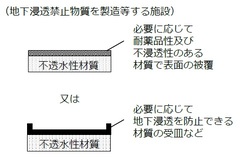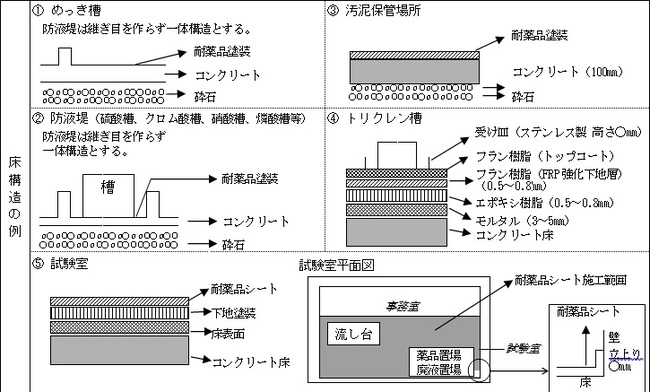Here's the text.
Regulations on underground penetration
About prohibition of underground penetration of drainage based on the regulations about conservation, etc. of Yokohama-shi living environment
Last update date April 1, 2024
Prohibition of underground penetration of prohibited substances
Businesses must not infiltrate water or other liquids pertaining to the work of manufacturing, using, treating, and storing underground infiltration prohibited substances listed in the following table (Article 29, Paragraph 1 of the Ordinance).
In addition, a company that manufactures, uses, treats, and stores underground infiltration prohibited substances must have the following structure when installing facilities related to the same work (Ordinance Article 29, Paragraph 2).
①The floor is an non-permeable material such as concrete that can properly prevent underground penetration of prohibited substances, and depending on the type and properties of underground infiltration prohibited substances handled on the surface, covered with chemical-resistant materials as necessary Or measures have been taken to prevent the penetration of underground infiltration prohibited substances, such as installing a saucer of a material that can prevent underground infiltration under the facility related to the work. (Article 36, Item 1 of the Enforcement Regulations)

②Measures to prevent the outflow of underground infiltration prohibited substances, such as installing a solution embankment around facilities that handle underground infiltration prohibited substances, if necessary according to the amount and work of underground infiltration prohibited substances, have been taken. thing. (Article 36, Item 2 of the Enforcement Regulations)
Example of floor structure

| No. | Substances that prohibit underground penetration |
|---|---|
| 1 | Cadmium and its compounds |
| 2 | Cyanide compounds |
| 3 | Organic phosphorus compounds (limited to palation, methylparation, methyl dimeton and EPN) |
| 4 | Lead and its compounds |
| 5 | Arsenic and its compounds |
| 6 | Mercury and alkyl mercury and other mercury compounds |
| 7 | Polychlorinated biphenyl (PCB) |
| 8 | Trichloroethylene |
| 9 | Tetrachloroethylene |
| 10 | Dichloromethane |
| 11 | Carbon tetrachloride |
| 12 | 1,2-dichloroethane |
| 13 | 1,1-dichloroethylene |
| 14 | 1,1,1-trichloroethane |
| 15 | 1,1,2-trichloroethane |
| 16 | 1,3-dichloropropene |
| 17 | Chiuram |
| 18 | Zimazine |
| 19 | Thiobencarb |
| 20 | Benzene |
| 21 | Selenium and its compounds |
| 22 | Boron and its compounds |
| 23 | Fluorine and its compounds |
| 24 | Ammonia, ammonium compounds, nitrite compounds and nitrate compounds ※1 |
| 25 | Dioxins ※2 |
| 26 | 1,4-dioxane |
| 27 | Hexavalent chromium compounds |
| 28 | 1,2-dichloroethylene |
| 29 | Vinyl chloride monomer (chloroethylene) |
※1 Excludes human waste and other items related to the application of sewage, livestock excrement, and fertilizers caused by living.
※2 A wastewater treatment plant that treats wastewater from establishments where air standards apply facilities stipulated in the Act on Special Measures against Dioxins are installed and sewage discharged from establishments where air standards apply facilities stipulated in the Act are installed. Limited to wastewater.
Inquiries to this page
Water and Soil Environment Division, Environmental Conservation Department, Green Environment Bureau
Telephone: 045-671-2489
Telephone: 045-671-2489
Fax: 045-671-2809
Email address: mk-mizu@city.yokohama.lg.jp
Page ID: 258-005-219







